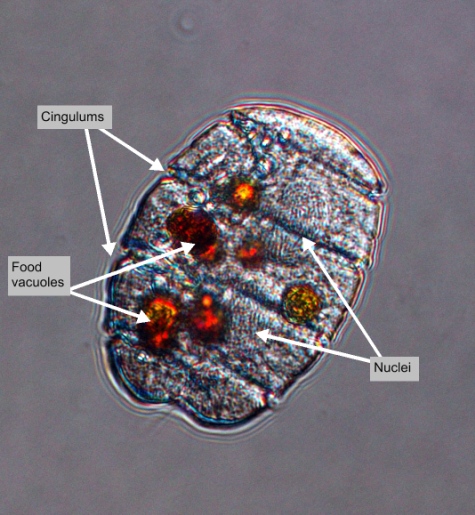


|
Synonym(s)
Classification
(Guiry and Guiry 2012)
Lifestyle
Description
Sulcus
"In dinokont dinoflagellates, the longitudinal area on the ventral surface that forms a furrow or depression and houses the longitudinal (trailing) flagellum" (Horner 2002).
sulcus (Kraberg et al. 2010). Usually, two zooids share a single CloseNucleus
(plural: nuclei) In eukaryotic cells, a membrane-bound organelle that contains the cell's genetic information; the nucleus controls the activities of the cell by controlling gene expression.
nucleus (Smithsonian 2012). Cell CloseCytoplasm
In a eukaryotic cell, a gel-like substance within the cell membrane that contains all the organelles except for the nucleus.
cytoplasm is green or pink, depending on the cell's food source (Smithsonian 2012). Cells lack chloroplasts but have CloseNematocyst
An ejectable organelle with stinging, sticky threads. Nematocysts are used by some dinoflagellates to capture prey (Smithsonian 2012). This term is primarily used to describe specialized stinging cells in jellyfish.
nematocysts and food CloseVacuole
A membrane-bound organelle found in some protists, containing a water solution of organic and inorganic molecules (including enzymes). In some cases, vacuoles may contain engulfed solids (Falkowski et al. 2004).
vacuoles placed centrally (Kraberg et al. 2010). P. schwartzii has spherical CloseCyst
"A thick-walled dormant cell" (Horner 2002).
cysts with a network of protrusions that form a mesh around the cell (Horner 2002).Measurements
Similar species
Oblique
At a slanted angle (i.e., not parallel or perpendicular).
oblique sulcus displaced towards the left side of the cell (Kraberg et al. 2010).Harmful effects
Habitat
Distribution
Polykrikos schwartzii is common in coastal waters throughout the world except for polar seas. It is mostly confused for P. kofoidii hence, exact distribution is not known (Smithsonian 2012). It is also often seen in surface sediments from tropical to sub-arctic coastal regions (Matsuoka et al. 2009).
Polykrikos schwartzii is mostly seen in summer and autumn (Kraberg et al. 2010).
Growth conditions
Nutrients
Various chemical substances that an organism needs for metabolism (i.e., to live and grow). These are usually taken up from the environment. Some examples include nitrate, phosphate, silica (for diatoms), iron, copper, etc. Some nutrients, like copper, are required for growth, but can also be toxic at high levels.
nutrient levels and turbulent water conditions (Matsuoka et al. 2003).Environmental Ranges
Temperature range (°C): -0.164 - 28.438
Nitrate (μmol L-1): 0.153 - 21.810
Salinity: 12.594 - 39.013
Oxygen (mL L-1): 3.529 - 9.046
Phosphate (μmol L-1): 0.091 - 1.482
Close
Silicic acid
A general term to describe chemical compounds containing silicon, oxygen and hydrogen with a general formula of [SiOx(OH)4-2x]n. Diatoms polymerize silicic acid into biogenic silica to form their frustules (Azam and Chisholm 1976).
Silicate (μmol L-1): 0.927 - 25.813(EOL 2012)
Bloom characteristics
References
Encylopedia of Life (EOL) 2012. Polykrikos schwartzii Butschli 1873. http://eol.org/pages/90350/details. Accessed 29 Feb 2012.
Guiry, M. D. and Guiry, G. M. 2012. Polykrikos schwartzii Butschli 1873. http://www.algaebase.org/search/species/detail/?species_id=56363. Accessed 29 Feb 2012.
Kraberg, A., Baumann, M. and Durselen, C. D. 2010. Coastal Phytoplankton Photo Guide for Northern European Seas. Verlag Dr. Friedrich Pfeil, Munchen, Germany. 203.
Matsuoka, K., Joyce, L., Kotani, Y. and Matsuyama, Y. 2003. Modern dinoflagellate cysts in hypertrophic coastal waters of Tokyo Bay, Japan. Journal of Planktonic Research. 25(12): 1462-1470.
Matsuoka, K., Kawami, H., Nagai, S., Iwataki, M. and Takayama, H. 2009. Re-examination of cyst-motile relationships of Polykrikos kofoidii Chatton and Polykrikos schwartzii Bütschli (Gymnodiniales, Dinophyceae). Review of Palaeobotany and Palynology. 154(1-4): 79-90.
Smithsonian Institution. 2012. Polykrikos schwartzii Butschli 1873. http://www.sms.si.edu/irlspec/Polykr_schwar.htm. Accessed 29 Feb 2012.
